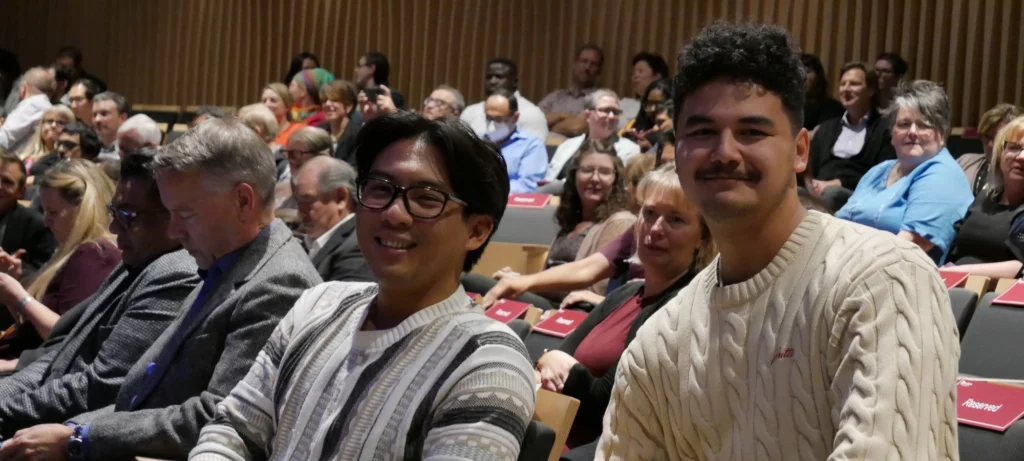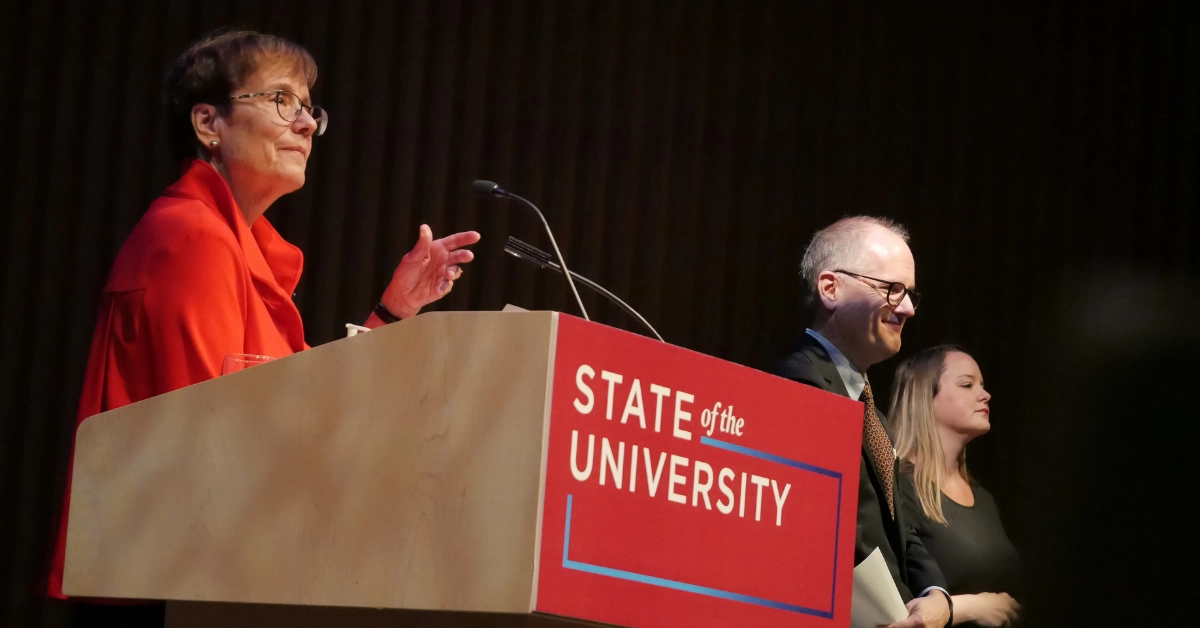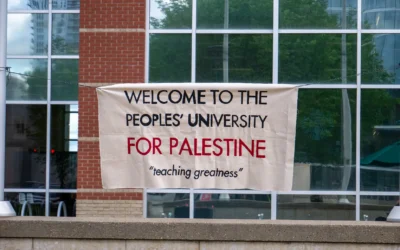On Oct. 19, Annette Trimbee, MacEwan’s president and vice-chancellor, presented the “Powered by Place” address to the university. The event took place in the Betty Andrews Recital Hall, and was attended by many faculty members and members of MacEwan and SAMU’s governance teams. The address’s purpose was to acknowledge MacEwan’s progress in achieving the “Teaching Greatness: Strategic Vision 2030.”
The Teaching Greatness strategic vision includes the five following objectives: improving MacEwan’s undergraduate experience, giving students flexibility when completing their degrees, preparing students for their desired professions, shaping students who contribute to Alberta’s success, and acquiring scholarships to improve the downtown community.
The address began with provost and vice-president Craig Monk acknowledging the Indigenous land on which MacEwan was built, a prayer from knowledge keeper George Dejarlais, and remarks on MacEwan’s history as a small community college.
“Where we were once humble, we now challenge ourselves to be bold, and unapologetically be key when we celebrate our achievements more enthusiastically.”
Annette Trimbee, president and vice-chancellor of MacEwan
“‘The city is our campus”— 50 years ago, those were the words used to describe MacEwan, which at the time was just coming to life as a small community college,” said Trimbee. She described how MacEwan evolved throughout the years and settled into its reputation as a strong university with humble beginnings.
Trimbee stated that it is now time for MacEwan to achieve greatness. She said: “I feel we are at a watershed moment in our history as an institution, one where we are stepping more fully into our place, embracing our strengths and challenging ourselves to take us even further. Where we were once humble, we now challenge ourselves to be bold, and unapologetically be key when we celebrate our achievements more enthusiastically.”
As part of MacEwan’s progress to grow, it had committed to its plan to build the new school of business which will contribute to its “Teaching Greatness” objectives.
Teaching Greatness
MacEwan’s “Teaching Greatness” objective is about providing students with work-integrated learning and excellent undergraduate education.
“In our fall and winter terms, an average of 20,000 students, staff, and faculty come downtown to MacEwan University every day,” said Trimbee. “They come to learn, to teach, to aspire, and understand their place as leaders and community builders.”
Last year, MacEwan had an intake of 12,500 full-time equivalent students; MacEwan wants to accommodate more of these students. The strategic vision has a goal of increasing full-time student intake to 14,200 students in 2025, and 20,000 students in 2030.
In regards to teaching “greatness”, MacEwan hopes to create and develop programs that are appealing to students and highly valued in the job market.
Smashing the Calendar
Trimbee refers to “smashing the calendar” as a means of providing students with a flexible education. MacEwan hopes to give students more options when it comes to pursuing their education. As part of the strategic vision, students are able to attend university, receive their credentials, and possibly return to deepen their education.
According to Trimbee, MacEwan students will be able to “[assemble] a unique package of knowledge, experience and skills to drive their future forward.” With a variety of multi-disciplines, students will have a specialized and customized education.
The strategic vision’s objective to give students flexible programs extends to the length of programs. With a customizable education, some students might be able to complete four-year programs in three years.
Grand as a Griffin
As part of fulfilling its strategic vision, MacEwan will teach students so that they are fully prepared for the future. MacEwan students will have work-integrated learning (WIL) opportunities that will help them succeed in their chosen career field.
“We are here to grow and inspire the next generation. What they learn and experience in this place will profoundly affect places beyond campus, and will become peers in our community.”
Annette Trimbee
Additionally, organizations and sponsors will choose to partner with MacEwan; a benefit of these partnerships will enrich program quality, provide scholarships and bursaries, and fund student support services like the Centre for Sexual and Gender Diversity as well as student research.
According to Trimbee, last year students received $8.20 million in financial support through 1,559 scholarships, 2,242 bursaries, and 1,361 awards.
“These numbers, while impressive, are more meaningful when you appreciate that these gifts impact individual students directly,” said Trimbee, “some of whom would not be able to even contemplate coming to post-secondary.”
Perpetual Motion
On top of providing students with skills and knowledge that is attractive to employers, the strategic vision states its goals to have its students give back to the downtown community and contribute to Alberta’s economy.
By implementing work-integrated learning into programs, students are able to shape Edmonton’s community by working to address and resolve real-life problems that affect the community. Last year, however, 5,100 WIL placements were available to students; according to Trimbee, MacEwan will attempt to implement WIL into all eligible programs by 2030. In the 2022 to 2023 academic year, 78 per cent of programs had WIL components.
Trimbee said, “Our goal is to ensure 50 per cent of students have an experienced record by 2025, and 100 per cent of students will have one by 2030.”

But, according to MacEwan’s president, students are reflective of Alberta’s demographic. To promote reconciliation efforts, MacEwan hopes to reduce barriers for Indigenous students and provide them with opportunities.
Trimbee stated: “In “Teaching Greatness,” we recognize the importance of ensuring the demographics of our student body more closely reflect our community with greater participation from indigenous and other historically underrepresented learners.”
By 2030, MacEwan expects to increase the percentage of Indigenous students to 8 per cent.2
Trendsetters and Trendbreakers
One of the strategic vision’s objectives is to nurture and promote scholarly research. Trimbee praised, and reiterated the importance of the “power of the place” in regards to MacEwan’s physical location in the O-day’min ward.
MacEwan’s new business building will help contribute to the revitalization of downtown, but student-led research and projects will also impact the downtown community and contribute to other academic research.
“We are here to grow and inspire the next generation,” said Trimbee. “What they learn and experience in this place will profoundly affect places beyond campus, and will become peers in our community.”
To accommodate MacEwan students’ research and ambitions, MacEwan hopes to hire more faculty and staff. In particular, MacEwan will increase the number of courses taught by tenured faculty members. Additionally, the strategic vision states MacEwan’s objective to have over 50 per cent associate and full professors teaching first-year courses.
Question period
Trimbee’s address ended with a question period in which she addresses questions and concerns about the “Teaching Greatness” strategic vision.
One faculty member expressed concern about accommodating new students despite the university’s current spacing issue. Trimbee acknowledged that MacEwan will have to implement hybridization as a compromise. Although the new business building will house more students, MacEwan will have to work with its resources.
“Part of the solution is to use our space in smarter ways,” said Trimbee.
Another faculty member asked about MacEwan’s ability to offer students services and resources with an increase in students on campus. Trimbee said that MacEwan would need to hire more faculty members and staff to provide student services, and to regularly check on the need of these services.
“. . . Part of that is hiring faculty [and] staff, and expanding our space, and investing in the right services in the right order,” responded Trimbee.
In regards to MacEwan’s progress as a university, one faculty member asked whether Trimbee knew how it would affect the community’s perception about MacEwan as a post-secondary institution.
Trimbee suggested that MacEwan thoughtfully analyze its engagement with the community. Rather than use the number of engagement as a way to understand other peoples’ perception of MacEwan, the institution should consider how it impacts other communities like downtown or the post-secondary sphere.
Photos by Liam Newbigging





0 Comments